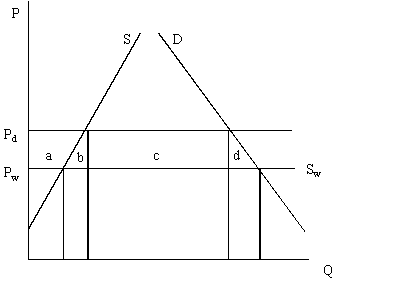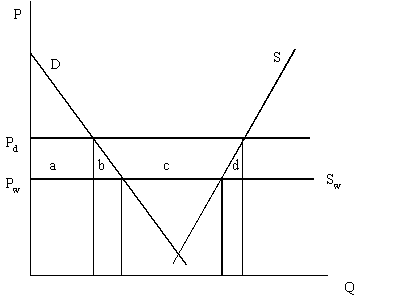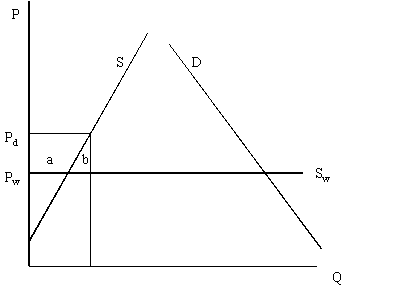
Suppose that imports are available from the rest of the world at a constant supply price
Pw (small open economy assumption). This price represents the opportunity cost to a country of the commodities
it produces or consumes, in the sense that it is the value of the next best alternative source of supply (imports)
or the value of what the country would get if it abstained from consumption (exports). Suppose that the government
is persuaded that domestic production should be supported, and it imposes a tariff on imports. The volume of imports
falls, and the domestic price rises by the amount of the tariff. The tariff creates a wedge
between the domestic producer and consumer prices and the world price. These wedges can be considered
as a policy distortion and impose an overall economic cost on the society.
To measure this cost, the changes in producer, consumer and taxpayer welfare can be aggregated, as follows.
Change in consumer surplus
-(a+b+c+d)
Change in producer surplus
a
Change in taxpayer expenditure
-c
Change in overall welfare
-b-d
Note that b represents the excess resource cost of
producing at home what would be cheaper to import from abroad, and that d represents the cost to consumers of being forced to alter their preferred basket of consumption
commodities.
An import tariff can be imposed as an ad valorem (percentage)
tariff, e.g. 20%, or a specific (absolute) tariff,
e.g. £20 per tonne, or some combination of the two (a mixed tariff). Note that an ad valorem import tariff raises the domestic price, but does not necessarily
stabilise it if the world price is unstable. However, an absolute tariff has a small stabilising effect, as the
tariff is relatively smaller when world prices are high, and relatively larger when world prices are low. Partly
for this reason, many EU agricultural tariffs are either specific or mixed tariffs. Note also that domestic production
instability has no effect on the domestic price, but is reflected instead in changes in the volume of imports.
Of course, if the import tariff is made a variable (called a variable import levy), then it is possible for the importing country to stabilise the domestic price, regardless of the
source of the instability. This was the mechanism used by the EU under many of its CAP commodity regimes. In Lecture
17, we discuss the adverse impact of this policy on other trading partners.
Note that an import quota is not the same as a production quota considered in Lecture 13. An import
quota can be illustrated using the same diagram as an import tariff but the price and welfare effects are not necessarily
the same. By restricting imports the domestic price can be increased from Pw to Pd. The resulting changes in producer,
consumer and taxpayer welfare are as follows.
The main difference with a tariff is that the tariff revenue is foregone by the importing country. In fact, the
quota rent accrues to the exporting country, which
now finds that it is able to charge a higher price (namely, Pd) on a smaller export quantity. Depending on the
elasticities of domestic supply and demand, it is possible that the exporting country will actually be better off
as a result of an import quota. This is the basis for voluntary export restraint (VER) agreements entered into between importers and exporters, and explains why exporting countries
were ready in the past to accept apparently discriminatory restrictions on their exports.
Change in consumer surplus
-(a+b+c+d)
Change in producer surplus
a
Change in taxpayer expenditure
0
Change in overall welfare
-b-c-d
Where an import quota is used, it must be policed through the use of either import or export licences. The distribution
of the quota rent will depend on the way in which these licences are allocated. If the licences are given to the
exporter to distribute (as is usually the case under a VER agreement), this ensures that, indeed, the exporter
benefits from the quota rents. However, if the licences are given to traders in the importing country, then the
importing country can capture the quota rents. This is because these traders can play one exporter off against
another to force the price down, effectively back to the world market level. In practice, we might expect the quota
rents to be shared between importers and exporters. This is a highly contentious issue, for example, in the operation
of the EU banana import regime post-1992 which restricted imports of so-called 'dollar bananas' from more
efficient Latin American banana exporters in order to protect preferred ACP suppliers under the Lome Convention.
Another difference between tariffs and import quotas concerns their impact on price stability. An import quota
will protect the domestic market against imported world market instability, but it cannot offset the effects of
domestic production instability (the opposite to an import tariff) - unless, of course, the import quota quantity
is itself a variable (the analogy with a variable import levy).

An export subsidy introduces no new conceptual issues. Of course, if a country uses an export
subsidy to raise the domestic price above world market prices, it follows that it must also have some mechanism
in place to prevent cheaper world market imports from taking advantage of this higher domestic price. So an export
subsidy will always be accompanied by some form of import control as well. But the welfare effects are similar
to an import tariff. Note that the change in taxpayer expenditure is calculated as the (new) volume of exports
multiplied by the size of the unit export subsidy.
Change in consumer surplus
-(a+b)
Change in producer surplus
a+b+c
Change in taxpayer expenditure
-(b+c+d)
Change in overall welfare
-b-d
Some countries, particularly developing countries, have resorted to a tax on exports, designed to keep the domestic price of the good below the export price. The analysis follows the same principles as for an export subsidy.

This was the preferred method in the United Kingdom of supporting its agricultural producers
prior to its EU membership in 1973 and is also used in US farm policy. It is particularly attractive to an importing country that wishes to maintain
a cheap food policy for its consumers. Farmers are guaranteed a target price Pd, and any 'deficiency' between it
and the actual market price (which in this case is the world price, as there are no barriers against imports from
third countries) is paid as a direct payment by the government.
The welfare analysis is particularly simple in this case
As with any direct payment, it is possible to limit the government's exposure by setting a ceiling on the maximum
amount of production which will be supported (either on a per farm or national basis).
Change in consumer surplus
0
Change in producer surplus
a
Change in taxpayer expenditure
-(a+b)
Change in overall welfare
-b
Governments have a variety of ways of supporting their farmers
Given the variety of policy interventions possible, it might be asked which alternative a government should choose, given the objective of making a given transfer to producers. From an economic perspective, it is possible to rank policy interventions according to the economic cost of making the transfer. We define this cost per unit of transfer as
Unit transfer cost 
where DW is the deadweight cost and PS is producer surplus. This concept is closely related to the transfer efficiency of alternative policies. From an economic perspective, one would want to choose the policy which minimises the economic cost of making a given transfer.
Ellis, F., 1992. Agricultural Policies in Developing Countries. Cambridge, Cambridge University Press, Chapter
3, 'Policy Analysis: Economics'.
Colman, D. and Young, T., 1989. Principles of Agricultural Economics, Cambridge, Cambridge University Press.
Chapter 12, 'Food and agricultural policy'.
Gaisford, J. and Kerr, W., 2001, Economic Analysis for International Trade Negotiations,Cheltenham, Edgar Elgar.
(An introductory level text combining simple PE supply-demand models with discussion of the the policy issues central to the agricultural and SPS negotiations in the WTO Doha Round.)
Good references to price policy analysis, though more detailed than required for our purposes, are:
Timmer, C.P., 1986. Getting Prices Right: The Scope and Limits of Agricultural Price Policy. New York, Cornell
University Press.
Tsakok, I., 1990. Agricultural Price Policy: A Practitioner's Guide to Partial Equilibrium Analysis. New
York, Cornell University Press.